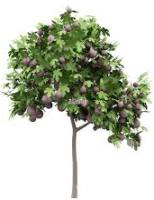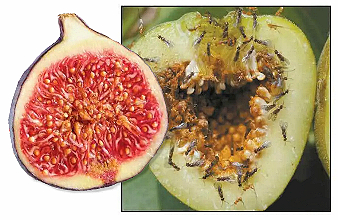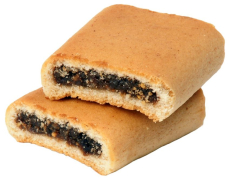 
 The fig is the edible fruit of Ficus carica, a species of small tree native to the Mediterranean as well as western and southern Asia. It's been cultivated since ancient times, and is now widely grown throughout the world.
The fig is the edible fruit of Ficus carica, a species of small tree native to the Mediterranean as well as western and southern Asia. It's been cultivated since ancient times, and is now widely grown throughout the world. Growing up to 12 metres tall, the fig tree has broad deciduous leaves that are deeply lobed and which exude a white latex sap when broken. There are over 750 species of fig trees worldwide.
It's believed that figs were one of the first plants cultivated by humans. Their history stretches back at least 11,000 years to Mesopotamia, now known as the Middle East.
Growing up to 12 metres tall, the fig tree has broad deciduous leaves that are deeply lobed and which exude a white latex sap when broken. There are over 750 species of fig trees worldwide.
It's believed that figs were one of the first plants cultivated by humans. Their history stretches back at least 11,000 years to Mesopotamia, now known as the Middle East.
  Figs aren't fruits; they're actually clusters of many, many inverted flowers. Pollinators need to get inside; this is accomplished by the fig wasp. This is a type of wasp, just 1.5 mm long, that exclusively pollinates figs. Although they die inside the fig, ripe figs are not full of dead wasps. The crunchy texture of figs is because of the seeds. The fig actually produces an enzyme called ficain, or ficin, which digests the dead wasps; the fig absorbs the nutrients to create the ripe fruits and seeds.
Figs aren't fruits; they're actually clusters of many, many inverted flowers. Pollinators need to get inside; this is accomplished by the fig wasp. This is a type of wasp, just 1.5 mm long, that exclusively pollinates figs. Although they die inside the fig, ripe figs are not full of dead wasps. The crunchy texture of figs is because of the seeds. The fig actually produces an enzyme called ficain, or ficin, which digests the dead wasps; the fig absorbs the nutrients to create the ripe fruits and seeds.
This shouldn't worry you. If you've ever licked a pink or red popsicle, eaten red candy, or enjoyed pink ice cream or yogurt, or even put on red lipstick, you should know that the red dye in them probably came from ground-up cochineal beetles. If your favourite food is peanut butter, you should be aware that it is very impractical to remove all traces of pests from ground-up peanuts; an average of one or more rodent hairs and 30 or so insect fragments are allowed for every 100 grams If you have the stomach for it, here are some more unpleasant facts about things you ingest. As far as figs go, several commercial varieties of fig are in fact self-pollinating; these varieties need not be visited by fig wasps to bear fruit. The top fig producers in the world are Turkey, Egypt, and Morocco. However, fresh figs are ripe for just a few weeks a year and canít be preserved. They're very soft, and donít ripen much once picked, so you canít pick them green and hope they're ripe by the time you sell them. Being very soft they get squashed easily. For these reasons you're most likely to encounter dried figs. California produces 100% of North America's dried figs.  Early Olympic athletes used figs as a training food. Figs were also presented as laurels to the winners, becoming the first Olympic 'medals'. Figs made their first commercial product appearance with the 1892 introduction of Fig Newton cookies.
Early Olympic athletes used figs as a training food. Figs were also presented as laurels to the winners, becoming the first Olympic 'medals'. Figs made their first commercial product appearance with the 1892 introduction of Fig Newton cookies.One-half cup of figs has as much calcium as drinking one-half cup of milk. Figs have more fiber than prunes, and more potassium than bananas. |